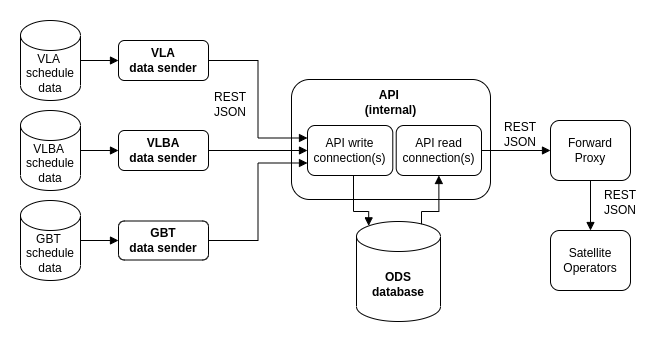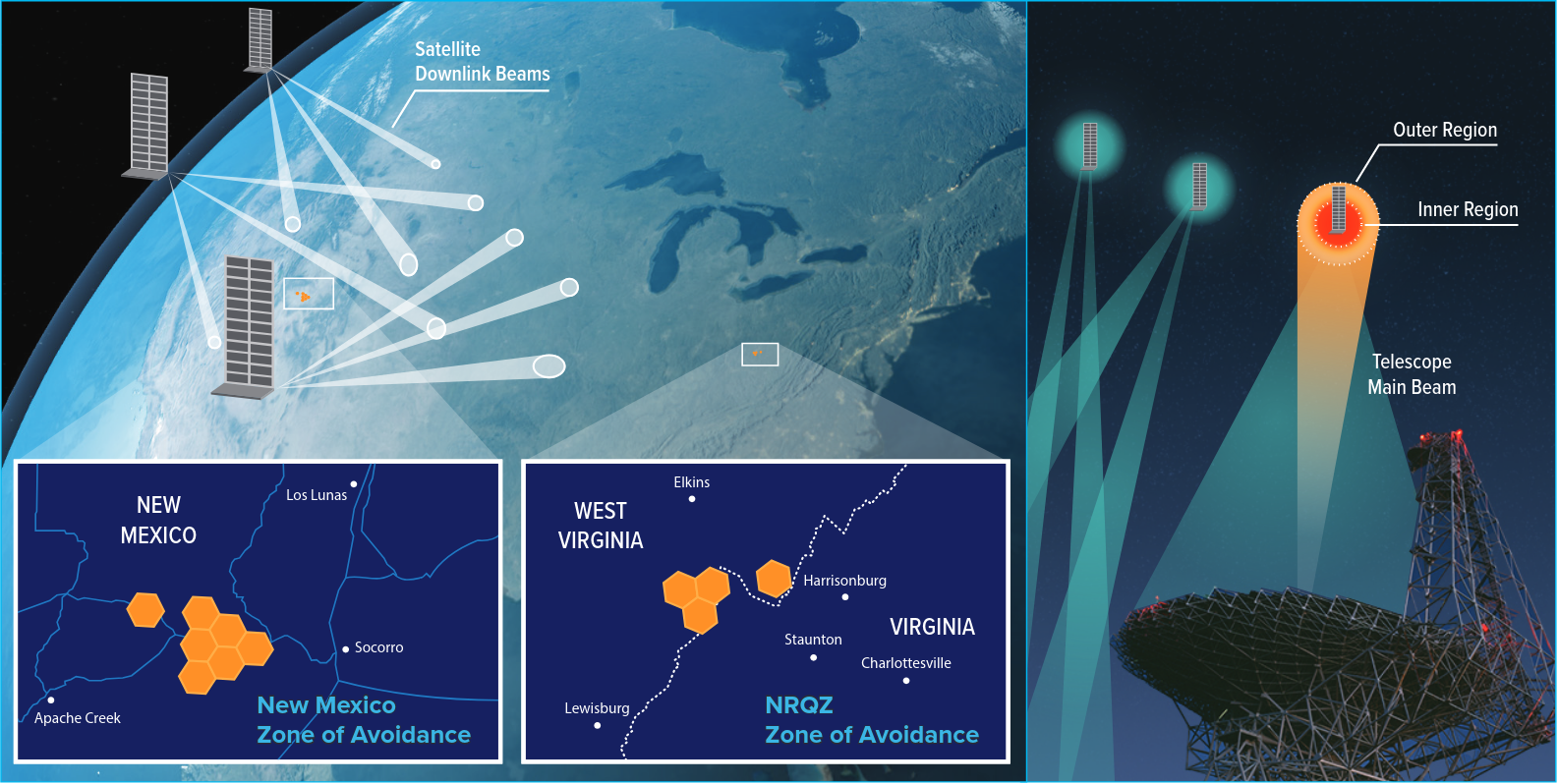1. Operational Data Sharing (ODS) v1.0.0
To mitigate radio frequency interference (RFI) of radio telescopes on Earth from Low-Earth Orbit (LEO) satellites’ broadband internet and cellular downlink services, the Operational Data Sharing (ODS) system provides information about current and near future observations of participating radio telescopes, including where their antennas are pointing and at what frequencies they are observing. Satellite operators can dynamically query for this information to reconfigure any satellites that may interfere with the observations, including activating the Telescope Boresight Avoidance (TBA). Noting that this technique is not meant to address the unintentional electromagnetic radiation (UEMR) from onboard electronics.
1.1. How ODS Works
ODS is NRAO’s attempt to facilitate near real-time communication of telescope status to satellite operators. By design, the functionality of the ODS at the NRAO/GBO telescopes should require no special actions on the part of observers, e.g., who submit their observing schedule (e.g., Scheduling Blocks for VLA) as they always have. The NRAO systems then process these data without any intervention from observers (See ODS Data JSON Fields for the ODS JSON fields). The ODS is also capable of disabling status reporting (e.g., for proprietary reasons) for certain observations by a particular observer upon request. In return, these observations will not be informed and protected by TBA.
Currently, the satellite operators are interfacing with the NRAO ODS API endpoint using a token-based authentication (See Authentication). By design, the ODS framework can be adopted by any satellite operators and radio observatories if they use the same data and API standards (See ODS Adoption).

Figure 1 - A high level block diagram of the current ODS prototype showing how NRAO’s VLA, VLBA, and GBO’s GBT report their observation schedules to the ODS server for satellite operators (Credit: NRAO/ESM).
1.2. How TBA Works
The main objective of the TBA is to help prevent extremely strong satellite downlink (DL) signals exposing the radio telescope’s main beam during occasional main-beam to main-beam interactions.
The TBA is a satellite tasking scheme developed by SpaceX and NRAO, that allows Starlink satellites to respond to the shared ODS radio telescope information (provided at some prearranged buffer time before observation starts). Once the Starlink system identifies that a satellite trajectory will pass close to a telescope boresight operating at one of its DL frequency channels, the satellite constellation takes one of three actions (as illustrated in Figure 2):
1) If the satellite passes outside of an agreed “outer boresight” region (defined as an angular separation from the boresight position on the sky), it takes no action.
2) If the satellite crosses into the “outer boresight” region, it will task its beams far from the radio telescope (typically 180 km) so that the telescope is only illuminated by the DL beam’s sidelobes.
3) If the satellite further crosses into an agreed upon “inner boresight” region, it will momentarily disable beam forming, completely quieting the phased array antenna and other related electronics.

Figure 2 - Illustration for the Telescope Boresight Avoidance technique showing how the Starlink satellites may operate when they are entering the inner and outer boresight angular regions close to the telescope main beam (Credit: NRAO/ESM).
1.3. Current NRAO/GBO facility adoption status
This table is a quick summary of the current NRAO/GBO facilities that have started uploading their observation status to the ODS API, and which satellite operators have started utilizing the ODS data for the Telescope Boresight Avoidance (TBA) technique.
Site |
Freq. range with TBA |
Effected receiver bands |
Satellite Operators adopted ODS |
Current TBA status |
|---|---|---|---|---|
1990-1995 MHz |
L, S |
SpaceX’s Starlink |
ACTIVE since Jan 2025 |
|
_ |
10.7-12.7 GHz |
X, Ku |
SpaceX’s Starlink |
ACTIVE since Aug 2024 |
10.7-12.7 GHz |
U |
TBD |
Under test since Sep 2025 |
|
_ |
41.0-45.0 GHz |
Q |
TBD |
|
1990-1995 MHz |
S, UWBR |
SpaceX’s Starlink |
Under development |
|
_ |
10.7-12.7 GHz |
X, Holography, Ku |
SpaceX’s Starlink |
Under development |